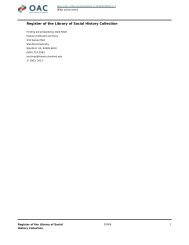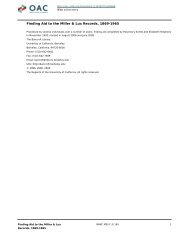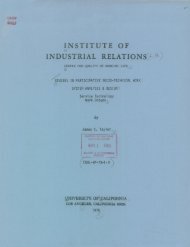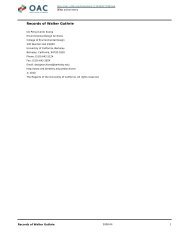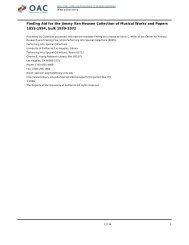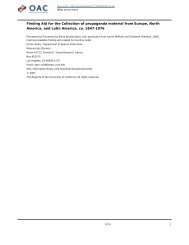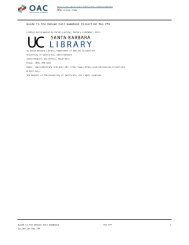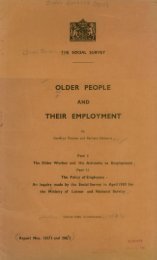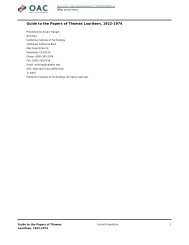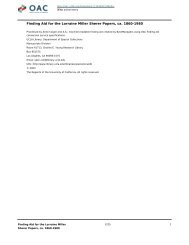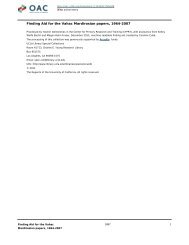Halsted B. Vander Poel Campanian collection - Calisphere
Halsted B. Vander Poel Campanian collection - Calisphere
Halsted B. Vander Poel Campanian collection - Calisphere
You also want an ePaper? Increase the reach of your titles
YUMPU automatically turns print PDFs into web optimized ePapers that Google loves.
<strong>Halsted</strong> B. <strong>Vander</strong> <strong>Poel</strong> <strong>Campanian</strong> Collection, circa 1570-1997, Getty Research Institute, Research Library, Accession no.<br />
2002.M.16<br />
Acquisition Information<br />
The <strong>collection</strong> was donated by <strong>Halsted</strong> B. <strong>Vander</strong> <strong>Poel</strong> in 2002.<br />
Processing History<br />
Ann Harrison rehoused the <strong>collection</strong> and created the series arrangement and finding aid in 2006.<br />
Separated Material<br />
Over 1,000 books and individual periodical issues from the <strong>collection</strong> were separated to the library. A search using the<br />
phrase "<strong>Vander</strong><strong>Poel</strong>" while selecting the index "Provenance" from the pull-down menu in the Getty online library catalog<br />
will retrieve a list of these separated materials, as well as the <strong>Vander</strong> <strong>Poel</strong> <strong>collection</strong>-level record and records for books<br />
remaining in the archive. Similar searches using "Della Corte" and "Warsher" in the Provenance index will retrieve books<br />
from these scholars' libraries.<br />
Biographical / Historical Note<br />
<strong>Halsted</strong> Billings <strong>Vander</strong> <strong>Poel</strong> (variant form <strong>Vander</strong><strong>Poel</strong>) was born in 1911 at the family estate in New York City. He<br />
graduated from Yale University with a Bachelor of Science degree in 1935 and then served in the Navy in World War II.<br />
After the war, he married, moved to Washington, D.C. and worked in the Truman and Eisenhower administrations.<br />
While still at Yale, <strong>Vander</strong> <strong>Poel</strong> developed a strong interest in eighteenth- and nineteenth-century English literature and<br />
soon began collecting books and manuscripts. <strong>Vander</strong> <strong>Poel</strong> quickly became established as a serious collector, and<br />
broadened his range to include Old Master paintings, American portraits and English furniture and silver.<br />
In 1956, <strong>Vander</strong> <strong>Poel</strong> moved to Rome. There he was involved in various cultural and educational projects, including the<br />
restoration of frescoes in Roman churches, and the administration of the Keats-Shelley Memorial House at the Spanish<br />
Steps. In 1964, he was one of the founders of St. Stephen's School, an American preparatory school in Rome.<br />
In Rome, <strong>Vander</strong> <strong>Poel</strong> met two archaeologists, Matteo Della Corte, a former Director of Excavations at Pompeii, and Tatiana<br />
Warscher, a leading historiographer of the site, and through them became fascinated with Pompeii. For the next forty<br />
years, <strong>Vander</strong> <strong>Poel</strong> devoted considerable time and financial resources to creating an extensive research library and archive<br />
on the archaeological investigations in Pompeii.<br />
In 1997 <strong>Vander</strong> <strong>Poel</strong> returned to the United States for health reasons. He died in Washington D.C. on June 27, 2003.<br />
Scope and Content of Collection<br />
The <strong>Vander</strong> <strong>Poel</strong> <strong>Campanian</strong> <strong>collection</strong> is a research archive assembled for the study of the history of the excavations at<br />
Pompeii and to a lesser extent, at Herculaneum and Stabiae. It represents the culmination of forty years of investigations<br />
by <strong>Vander</strong> <strong>Poel</strong>. He collected rare books, prints, photographs, maps and other original documents. He preserved the papers<br />
of Matteo Della Corte and Tatiana Warscher, left to him as bequests upon their deaths. He sponsored excavations and<br />
commissioned mapping and photography of the site. He funded and led a research team known as the Research in<br />
<strong>Campanian</strong> Archaeology (RICA) Group. His numerous projects, many still in the planning stages, included the production<br />
and distribution of the Corpus Topographicum Pompeianum, a multi-volume work on the history of the excavations at<br />
Pompeii; the production of updated editions of important research texts; and documentation of the Pompeian material in<br />
the Archaeological Museum at Naples.<br />
Until recently, the excavations at Pompeii have been poorly documented and the documentation that does exist has been<br />
dispersed throughout various European depositories and private <strong>collection</strong>s. Within this documentation, there is conflicting<br />
nomenclature and enumeration of locations. <strong>Vander</strong> <strong>Poel</strong>'s contribution to scholarship through the creation of his<br />
<strong>Campanian</strong> <strong>collection</strong> was the important, if not glamorous, task of collecting this dispersed information and supervising the<br />
creation of tools, ranging from concordances of house numbers to new maps of the site, which facilitate the study of<br />
Pompeii.<br />
This assembling of resources for the study of Pompeii accounts for the extremely broad date range of the <strong>collection</strong>. <strong>Vander</strong><br />
<strong>Poel</strong> worked on his <strong>Campanian</strong> projects and collected the material in the period roughly from 1958 to 1997. The broad date<br />
range of the <strong>collection</strong>, circa 1570-1997, reflects the dates of the materials, both original works and reproductions, within it.<br />
The highlights of the <strong>Campanian</strong> <strong>collection</strong> include Matteo Della Corte's field notes, Tatiana Warscher's photographic<br />
documentation of Pompeii, the unpublished notes of <strong>Vander</strong> <strong>Poel</strong>'s excavations of the Casa di Meleagro, manuscripts of the<br />
unpublished portions of the Corpus Topographicum Pompeianum, and the extensive scholarly documentation, both textual<br />
and visual, of Pompeii assembled by <strong>Vander</strong> <strong>Poel</strong>.<br />
Throughout this finding aid, all photographic prints and negatives are black-and-white, unless indicated as color. The house<br />
numbering used in the finding aid follows the current system of numeration for the site of Pompeii, see Andrew<br />
Wallace-Hadrill, Houses and Society in Pompeii and Herculaneum (Princeton: Princeton University Press, 1994), xix. The<br />
INVENTORY OF THE HALSTED B.<br />
VANDER POEL CAMPANIAN<br />
COLLECTION, circa 1570-1997<br />
2002.M.16 3



